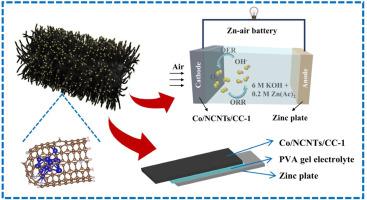Carbon cloth-based nitrogen-doped carbon nanotube-encapsulated Co nanoparticles as bifunctional oxygen electrocatalysts for flexible Zn-air batteries
IF 14.3
1区 材料科学
Q1 MATERIALS SCIENCE, MULTIDISCIPLINARY
引用次数: 0
Abstract
To enhance the performance of Zn-air batteries (ZABs), it is critical to reduce the energy barriers of the oxygen evolution reaction (OER) and oxygen reduction reaction (ORR) at the air cathode while accelerating their reaction kinetics. In this study, a self-supported bifunctional oxygen catalyst was prepared by growing nitrogen-doped carbon nanotubes (NCNTs) encapsulating Co nanoparticles on carbon cloth (CC), denoted as Co/NCNTs/CC. Benefiting from abundant active sites and a self-supported structure, the optimized Co/NCNTs/CC-1 exhibits a half-wave potential of 0.86 V for ORR and an overpotential of 243 mV at a current density of 10 mA cm−2 for OER. Density functional theory (DFT) calculations combined with experimental results reveal that the combination of Co nanoparticles and NCNTs improves the adsorption-desorption ability of oxygenated intermediates, synergistically enhancing the bifunctional catalytic efficiency. ZABs constructed with Co/NCNTs/CC-1 exhibit an open-circuit voltage of 1.45 V and demonstrate superior stability compared to ZABs assembled with Pt/C+RuO2. Additionally, flexible ZABs exhibit good battery performance and bending charge-discharge capabilities. This research offers a promising strategy for the development of non-precious metal catalysts for ZABs.

碳布基氮掺杂碳纳米管包封Co纳米颗粒作为柔性锌空气电池双功能氧电催化剂
提高锌空气电池的性能,关键在于降低空气阴极析氧反应(OER)和氧还原反应(ORR)的能垒,加快其反应动力学。在本研究中,通过在碳布(CC)上生长包覆Co纳米颗粒的氮掺杂碳纳米管(NCNTs),制备了自支撑型双功能氧催化剂,记为Co/NCNTs/CC。得益于丰富的活性位点和自支撑结构,优化后的Co/NCNTs/CC-1在ORR下的半波电位为0.86 V,在OER电流密度为10 mA cm - 2时的过电位为243 mV。密度泛函理论(DFT)计算结合实验结果表明,Co纳米颗粒与NCNTs的结合提高了含氧中间体的吸附-解吸能力,协同提高了双功能催化效率。与Pt/C+RuO2组装的ZABs相比,Co/NCNTs/CC-1构建的ZABs具有1.45 V的开路电压,并且具有更好的稳定性。此外,柔性ZABs具有良好的电池性能和弯曲充放电能力。本研究为ZABs的非贵金属催化剂的开发提供了一个有希望的策略。
本文章由计算机程序翻译,如有差异,请以英文原文为准。
求助全文
约1分钟内获得全文
求助全文
来源期刊

Journal of Materials Science & Technology
工程技术-材料科学:综合
CiteScore
20.00
自引率
11.00%
发文量
995
审稿时长
13 days
期刊介绍:
Journal of Materials Science & Technology strives to promote global collaboration in the field of materials science and technology. It primarily publishes original research papers, invited review articles, letters, research notes, and summaries of scientific achievements. The journal covers a wide range of materials science and technology topics, including metallic materials, inorganic nonmetallic materials, and composite materials.
 求助内容:
求助内容: 应助结果提醒方式:
应助结果提醒方式:


